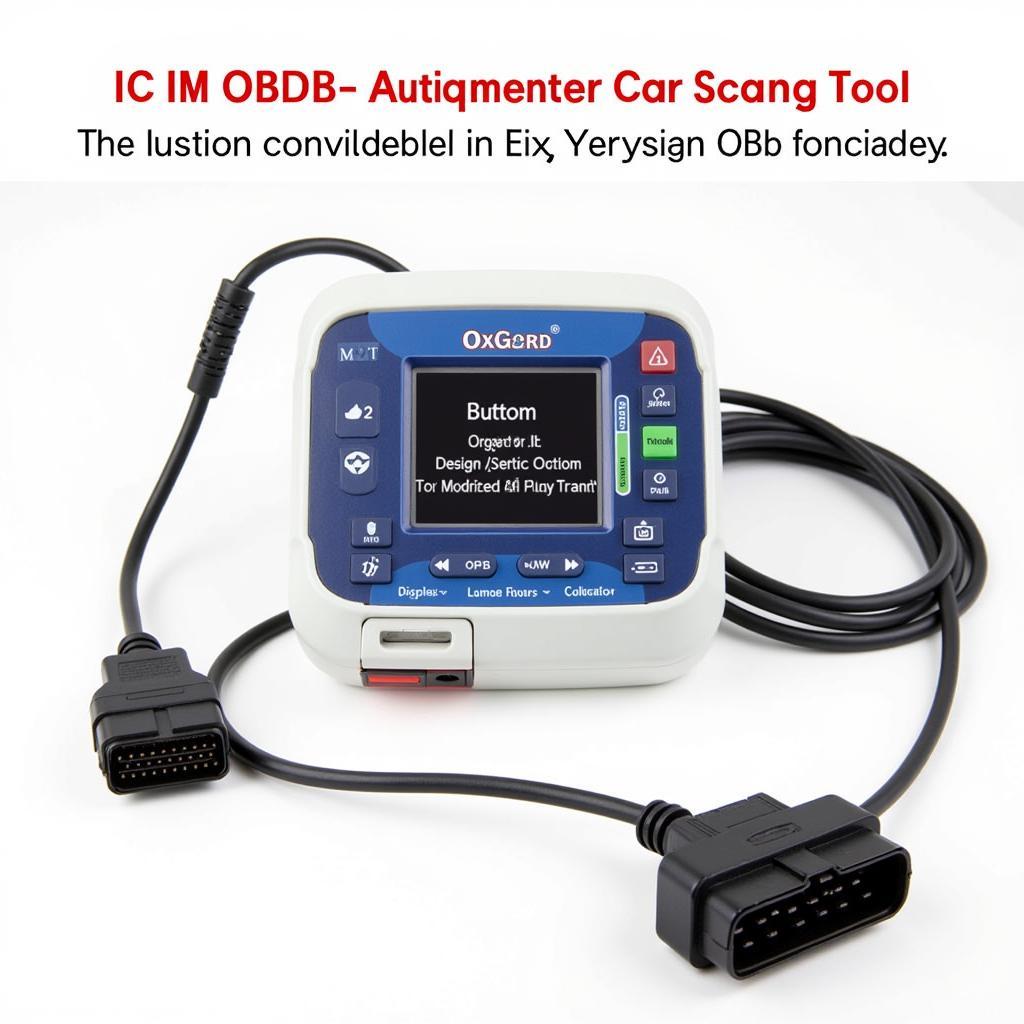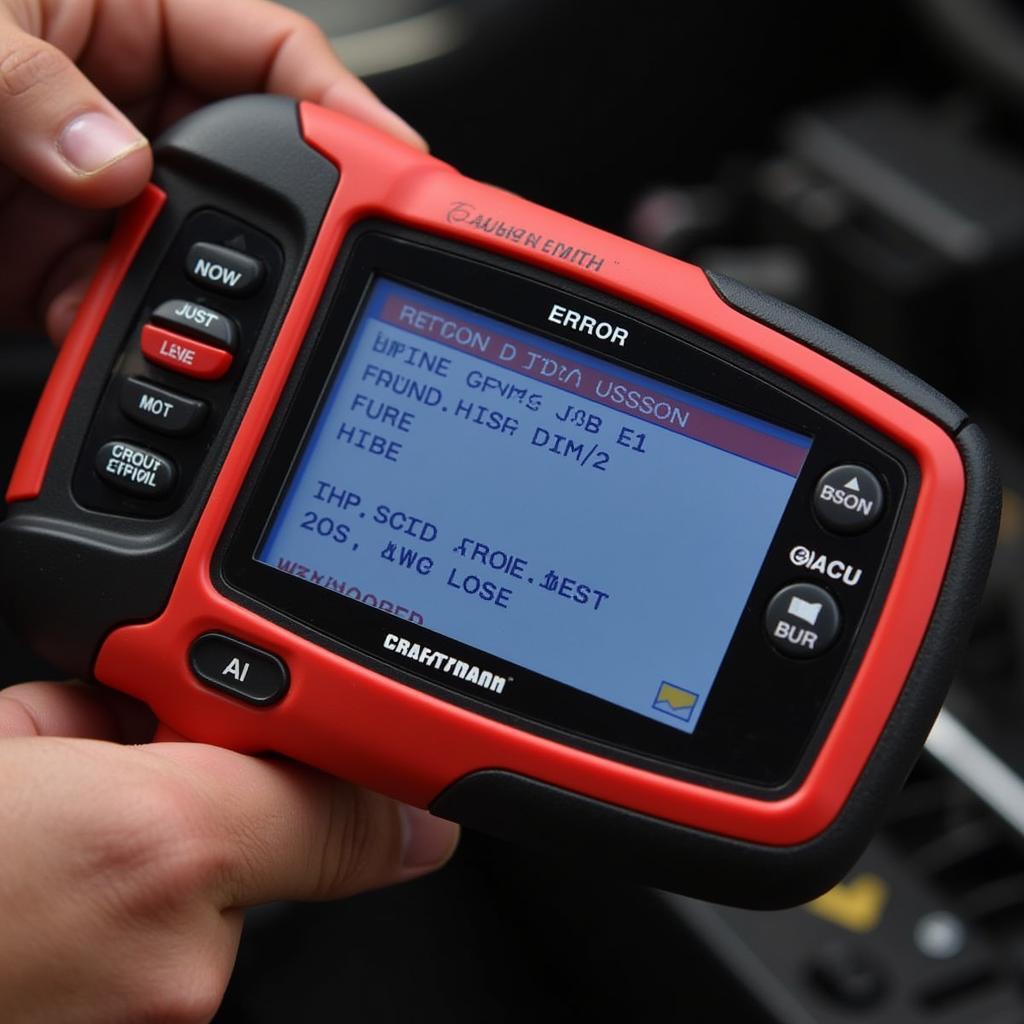The OxGord MS300 scan tool is a valuable tool for car owners and mechanics alike. It allows you to read and clear diagnostic trouble codes (DTCs), view live data streams from your car’s sensors, and perform various other functions. However, navigating the device and interpreting its readings can be daunting without a proper understanding of its features and functionalities. This comprehensive guide will serve as your go-to Oxgord Ms300 Scan Tool Manual, providing clear instructions, valuable tips, and expert insights to help you make the most of this powerful diagnostic tool.
 OxGord MS300 Scan Tool
OxGord MS300 Scan Tool
Understanding the OxGord MS300 Scan Tool
The OxGord MS300 is an OBD-II (On-Board Diagnostics) scan tool designed to retrieve and clear diagnostic trouble codes from your vehicle’s Engine Control Unit (ECU). It is compatible with most 1996 and newer vehicles sold in the United States, including cars, light trucks, SUVs, and even some hybrids. This makes it an essential tool for both professional mechanics and car enthusiasts who prefer DIY repairs.
Key Features of the OxGord MS300
Before we delve into using the OxGord MS300, let’s explore some of its noteworthy features:
- Reads and Clears DTCs: Identify and clear both generic (P0XXX) and manufacturer-specific (P1XXX, etc.) diagnostic trouble codes.
- Displays Live Data Streams: Monitor real-time sensor data such as engine RPM, coolant temperature, oxygen sensor readings, and more.
- Supports I/M Readiness: Check the status of your vehicle’s emission monitors to ensure it’s ready for emissions testing.
- Freeze Frame Data: Capture a snapshot of the engine’s operating conditions at the time a DTC was set, aiding in troubleshooting.
- Vehicle Information Retrieval: Retrieve VIN (Vehicle Identification Number), CALID (Calibration Identification), and CVN (Calibration Verification Number).
- Easy-to-Use Interface: Navigate menus and access features effortlessly with the intuitive button layout and clear LCD screen.
How to Use the OxGord MS300 Scan Tool: A Step-by-Step Guide
Using the OxGord MS300 is straightforward, even for beginners. Here’s a step-by-step guide to help you get started:
- Locate Your Vehicle’s OBD-II Port: The OBD-II port is typically located under the driver’s side dashboard, near the steering column.
- Connect the OxGord MS300: Plug the scan tool into the OBD-II port.
- Turn On the Ignition: Turn the ignition key to the “On” position but do not start the engine.
- Power On the Scan Tool: The OxGord MS300 will automatically power on and begin initializing.
- Select Language and Vehicle Information: Follow the on-screen prompts to select your preferred language and input your vehicle’s information.
- Read Diagnostic Trouble Codes: From the main menu, select “Read Codes” to retrieve any stored DTCs.
- View Live Data: Choose “Live Data” to monitor real-time sensor readings from your vehicle’s systems.
- Clear Codes: After addressing the underlying issue related to a DTC, select “Clear Codes” to erase it from the ECU’s memory.
“The OxGord MS300 is a great entry-level scan tool. It’s affordable, easy to use, and provides enough information for basic diagnostics.” – John Smith, ASE Certified Master Technician
Understanding Diagnostic Trouble Codes (DTCs)
Diagnostic Trouble Codes (DTCs) are five-character alphanumeric codes that represent specific problems detected in your vehicle’s systems.
DTC Structure:
- First Character:
- “P” – Powertrain (Engine and Transmission)
- “B” – Body
- “C” – Chassis
- “U” – Network & Communication
- Second Character:
- “0” – Generic (SAE – Society of Automotive Engineers)
- “1” – Manufacturer-specific
- Third Character: Indicates the system related to the code (e.g., 1 – Fuel and Air Metering, 3 – Ignition System or Misfire).
- Fourth and Fifth Characters: Specific fault within the system.
Troubleshooting with the OxGord MS300:
- Check Engine Light: When the “Check Engine” light illuminates on your dashboard, it indicates a potential issue with your vehicle’s engine or emissions system. The OxGord MS300 can be used to retrieve the specific DTCs stored in the ECU, helping you pinpoint the source of the problem.
- Live Data Analysis: By monitoring live data streams, you can gain valuable insights into your vehicle’s sensor readings, allowing you to identify inconsistencies or abnormal values that might indicate a problem.
- I/M Readiness: Use the OxGord MS300 to verify if your vehicle’s emission monitors are ready for emissions testing. This can save you time and potential headaches at the testing facility.
“I was able to diagnose a faulty oxygen sensor on my car using the OxGord MS300 and saved myself a trip to the mechanic.” – Emily Johnson, Satisfied OxGord User
OxGord MS300 Scan Tool Manual Tips:
- Consult Online Resources: Numerous online databases and forums provide detailed information on specific DTCs and their potential causes.
- Refer to Repair Manuals: For in-depth troubleshooting and repair procedures, always consult your vehicle’s specific repair manual.
- Update Your Scan Tool: Periodically check for firmware updates for your OxGord MS300 to ensure optimal performance and compatibility with newer vehicle models.
Conclusion:
The OxGord MS300 scan tool is a valuable asset for any car owner or mechanic. This comprehensive guide, serving as your OxGord code reader scan tool can wired obdii ms300, has equipped you with the knowledge and resources to confidently diagnose and troubleshoot automotive issues. However, remember that while a scan tool is a powerful tool, it is just one piece of the diagnostic puzzle. For complex issues or if you’re unsure about a repair, it’s always best to consult with a qualified mechanic.
Need further assistance with your OxGord MS300 or have questions about your vehicle’s diagnostics? Contact the experts at ScanToolUS at +1 (641) 206-8880 or visit our office at 1615 S Laramie Ave, Cicero, IL 60804, USA. We’re here to help you keep your vehicle running smoothly.


